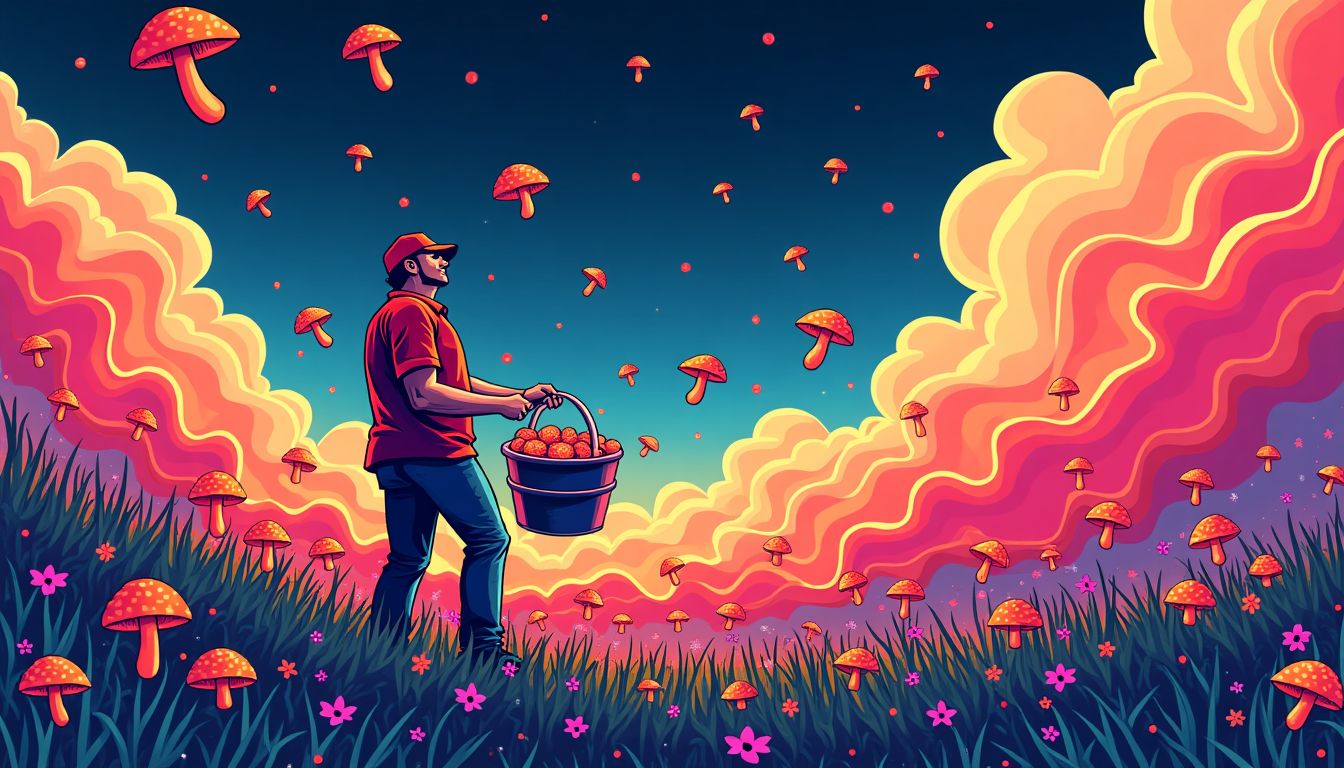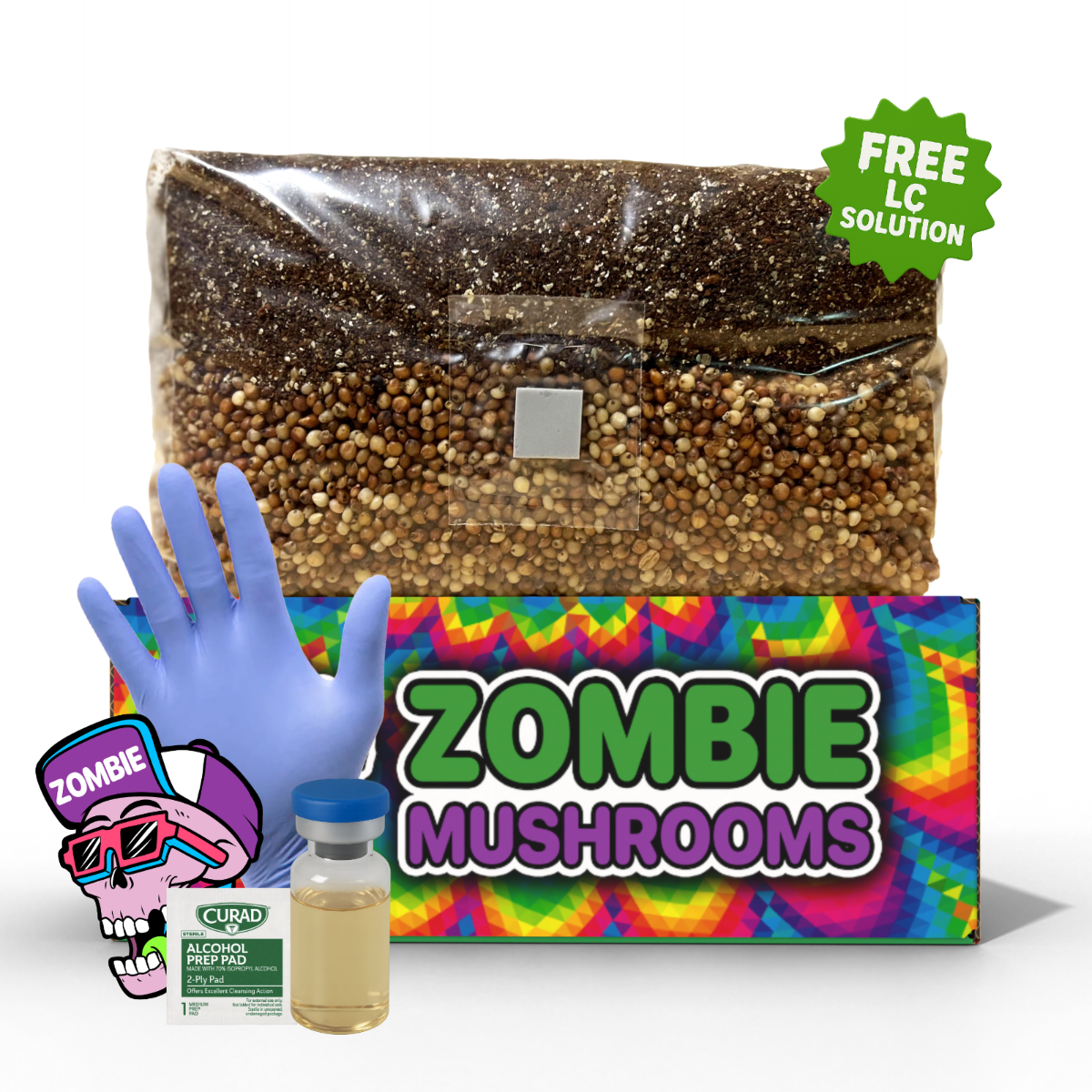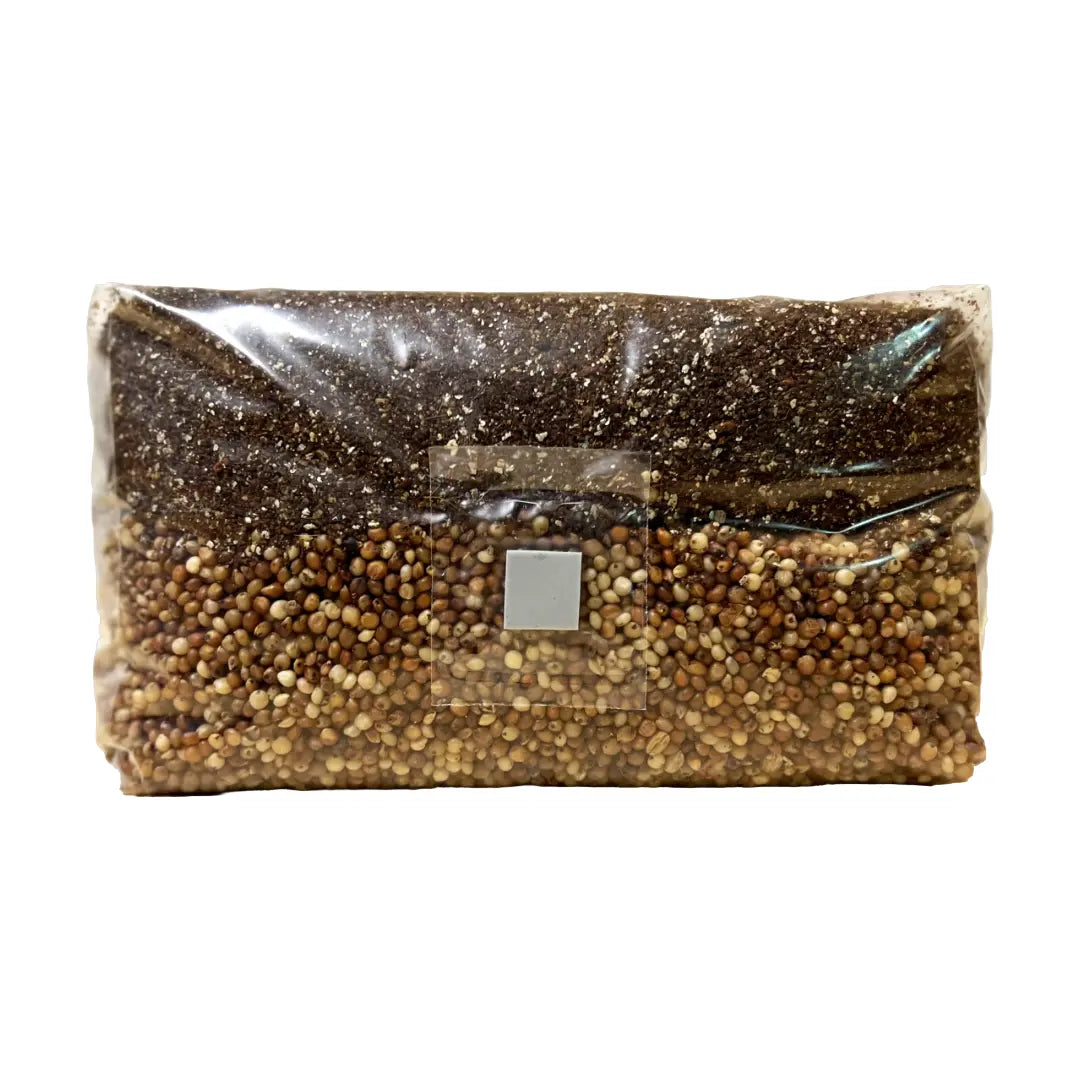Curious about how to grow magic mushrooms at home? This guide breaks down everything you need to know, from the initial setup to the final harvest. Follow these steps to start your own successful cultivation.
Key Takeaways
-
Magic mushroom cultivation requires knowledge of legal regulations, equipment, and sterile techniques to ensure healthy growth and compliance with local laws.
-
Two popular cultivation methods, monotub and grow bag, have distinct advantages; monotubs allow for larger yields while grow bags simplify the process for beginners.
-
Successful mushroom cultivation hinges on the careful selection and preparation of substrates, maintaining optimal environmental conditions, and proper harvesting and storage techniques.
Understanding Magic Mushrooms
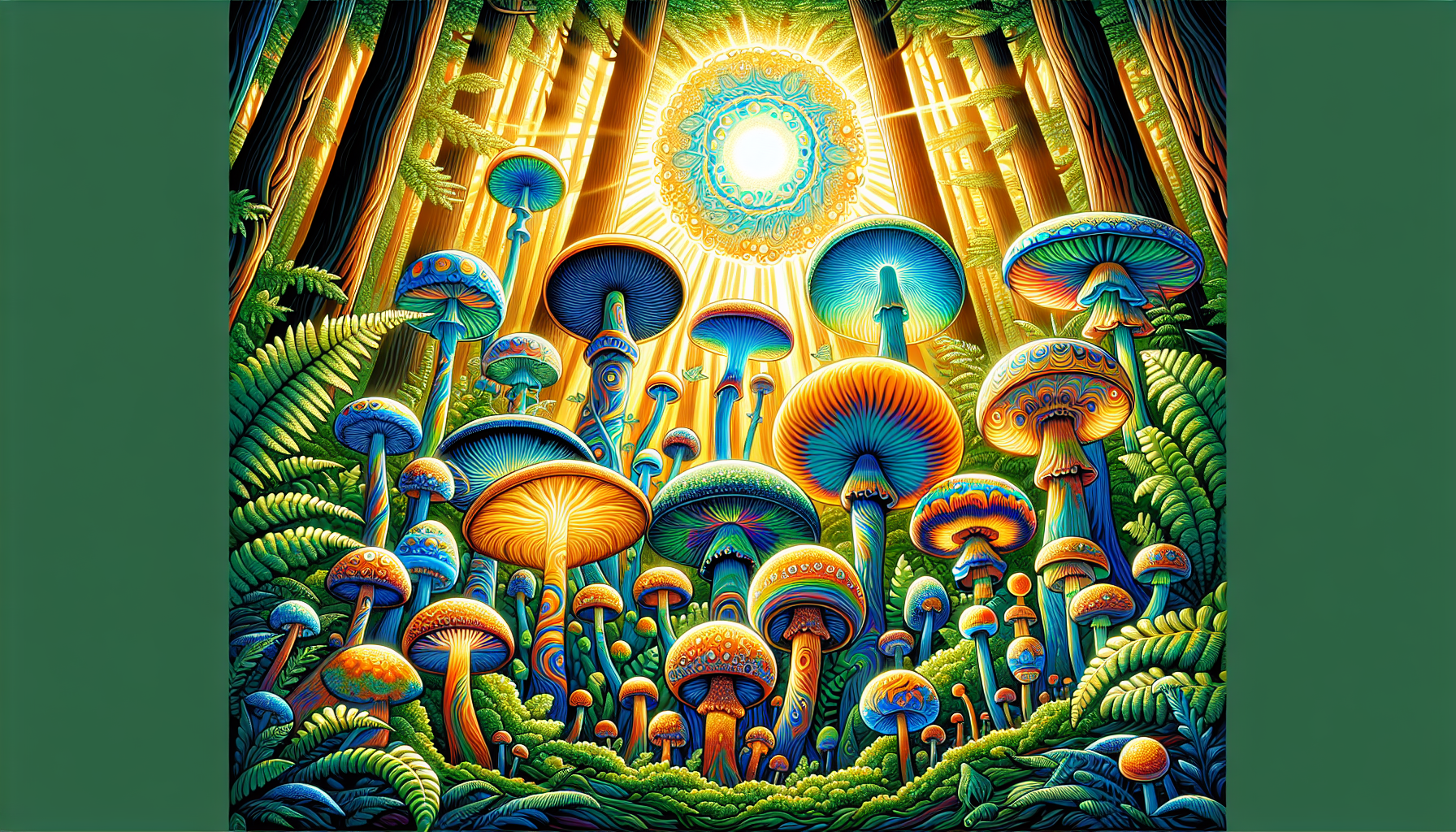
Psilocybin mushrooms, commonly referred to as magic mushrooms or psychedelic mushrooms, are a unique group of fungi endowed with psychoactive substances like psilocybin and psilocin. These chemicals bear structural similarities to serotonin and bind to 5-HT receptors in the brain, which can result in altered sensory experiences, mood fluctuations, and feelings of bliss. The onset of effects from consuming these compounds usually occurs within 20-30 minutes after ingestion, reaching their zenith between half an hour to almost an hour later, and such experiences tend toward concluding after about four to six hours.
The Psilocybe cubensis species stands out among various types of psychedelic mushrooms for its robust psychotropic capabilities coupled with the simplicity involved in cultivating it at home. Predominantly found across regions that experience tropical or subtropical climates, this particular variety has gained popularity amongst enthusiasts who engage in domestic cultivation due largely because of its strong resilience and versatile adaptability.
Embarking on the journey of growing magic mushrooms is not solely focused on understanding their mind-altering attributes but also delving into their historical usage for medicinal purposes alongside exploring potential therapeutic applications they may harbor. As growers begin nurturing these intriguing organisms at home, there lies an opportunity not just grasping required horticultural techniques, but Developing a profound respect for both cultural heritage attached them along personal exploration facilitated through cultivating fungi themselves.
Legal Considerations
Embarking on the cultivation of psilocybin mushrooms necessitates a comprehensive understanding of their legal status, which is inconsistent across various regions and countries. Some areas prohibit these fungi entirely, while others may allow them for certain uses like medical treatment or scientific research. To steer clear of serious legal repercussions that can stem from what could be deemed as drug manufacturing, it’s imperative to stay within the confines of local laws.
Although magic mushrooms aren’t directly addressed by UN drug conventions—resulting in an ambiguous global stance—their recognition has been growing due to decriminalization efforts and legalization for therapeutic applications in select places.
In many locations, owning mushroom spores themselves is legal because they lack both psilocybin and psilocin. Such legality fluctuates greatly between different territories. Prioritize verifying your regional guidelines thoroughly before initiating any efforts to cultivate magic mushrooms at home.
Essential Supplies and Equipment for Growing Magic Mushrooms
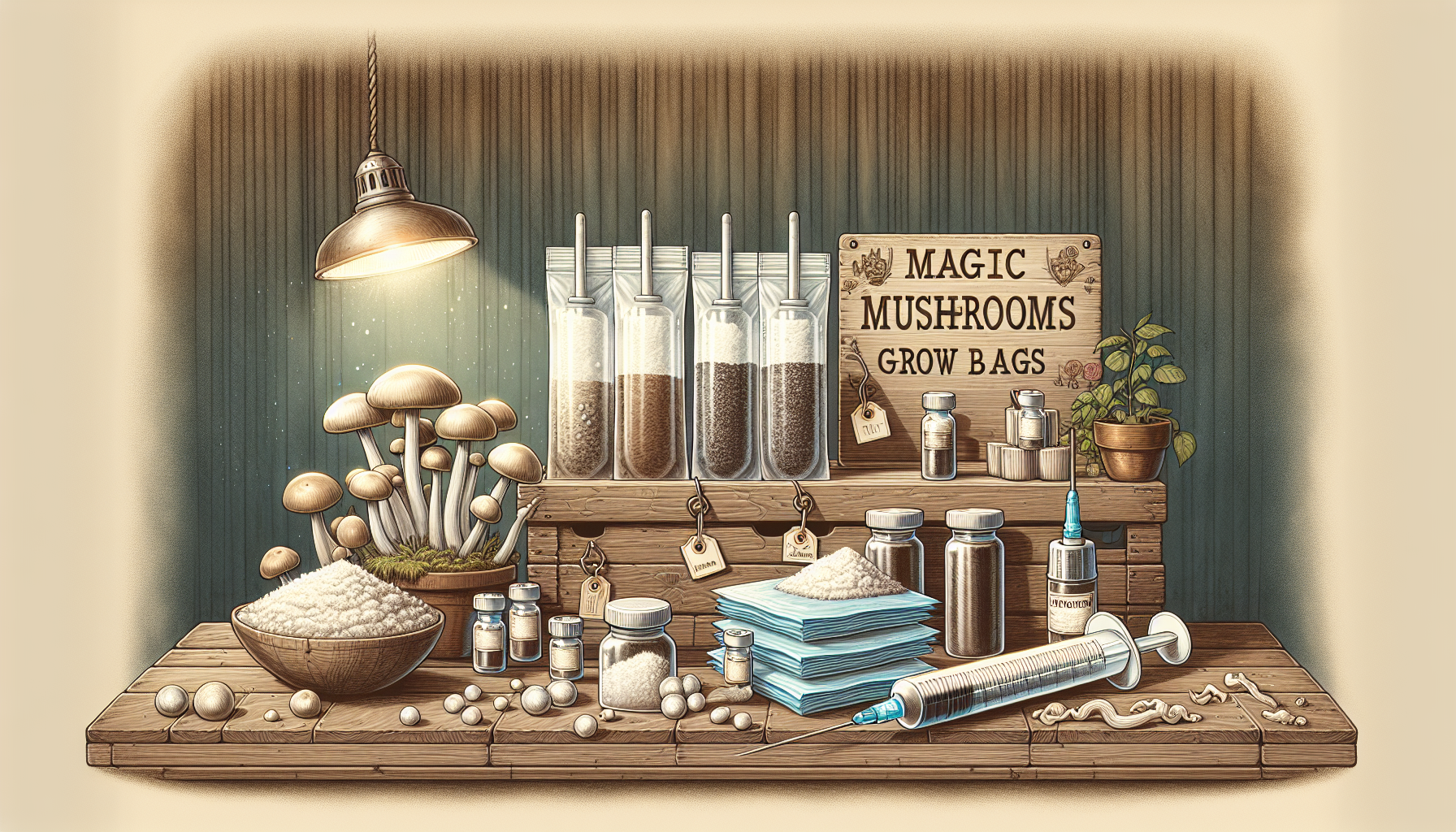
Embarking on the endeavor of psilocybin mushroom cultivation requires certain tools and materials. Key equipment includes:
-
Mushroom grain grain spawn
-
Sterile syringes to use for inoculation
-
Mason jars or grow bags suitable for housing the substrate
-
A spray bottle dedicated to keeping humidity levels in check
-
A precision scale for measuring ingredients with accuracy
It’s imperative to keep a close eye on environmental factors, so having a thermometer and hygrometer is crucial in monitoring both temperature and moisture content.
Utilizing grow tents can facilitate an optimal controlled space, which is particularly beneficial during the mushrooms’ fruiting phase. Ensuring cleanliness through protective gear like gloves combined with alcohol wipes is critical in preserving a sterile environment thereby averting potential contamination threats. An all-inclusive solution such as Zombie Myco’s All In One Mushroom Grow Bag offers home growers convenience by bundling together essential items – including sterile grow bag, alcohol wipe, and gloves – assisting newcomers embarking upon their cultivation endeavors.
Sterility takes center stage when it comes to using syringes for injecting spores. Although Zombie Myco does not supply either spores or liquid culture syringes itself, these can be sourced from alternative vendors. Equipped with appropriate apparatus while diligently upholding sterility principles will pave your way towards flourishing magic mushroom production at home.
Choose A Method: Monotub Vs Grow Bag
Selecting an appropriate method for mushroom cultivation is essential and can have a substantial impact on the success rate, including yield and simplicity of the process. Among home growers, two favored methods stand out: monotub setups and all-in-one grow bags due to their ease-of-use in fostering both edible and medicinal mushrooms.
The monotub technique involves utilizing a plastic container outfitted with filters that promote air exchange necessary for healthy mushroom growth. Monotubs provide ample space for development with flexible design options that allow integration of either manual or automated environmental control systems. They possess the ability to hold more substrate compared to grow bags, which may lead to increased yields.
In contrast, all-in-one grow bags are less expensive alternatives offering convenience as they arrive pre-sterilized thus minimizing potential contamination risks. These self-sufficient units streamline the mushroom growing experience making them particularly suitable for novices in mycology cultivation. Ultimately, each method has distinct advantages and disadvantages. Selecting between them hinges on individual needs regarding space availability, budget constraints, and personal preferences in managing the growing environment.
The Mushroom Monotub Method
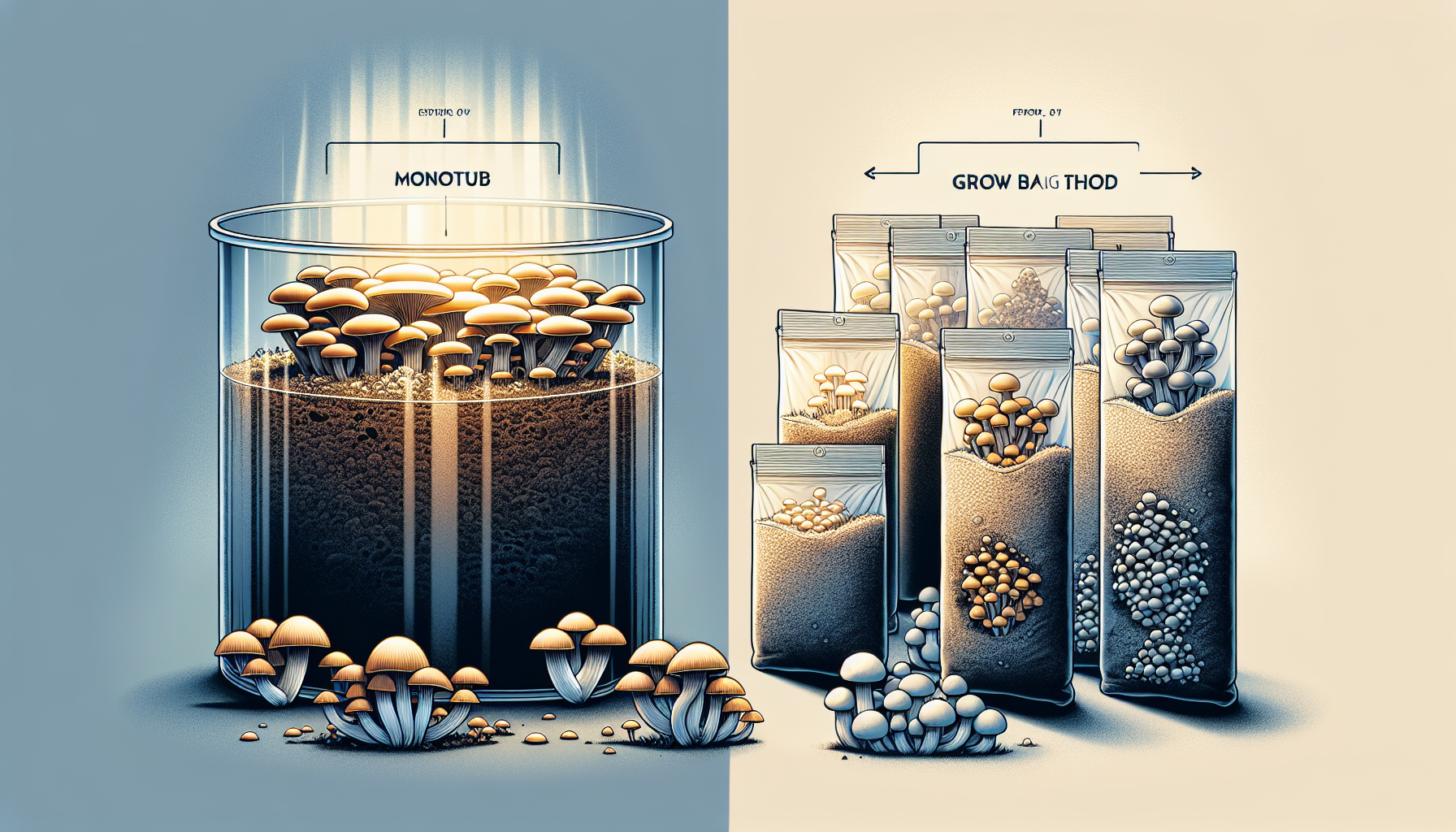
The monotub technique, commonly referred to as monotub tek, is a favored approach for growing mushrooms indoors thanks to its straightforward and effective design. This method involves using a plastic container with holes punctured around the edges to facilitate proper air circulation. These openings are equipped with filters that control airflow while sustaining optimal humidity levels essential during different phases of mushroom cultivation.
To initiate your own monotub setup, bore six 2-inch openings into the bin’s sides and seal them using either micropore tape or polyfill as an air filter medium. It’s crucial for this setup to be situated in an area where diffuse light can reach it since ambient lighting aids the fruiting stage of growth. Monitor for moisture indicators like condensation on both lid and substrate which denote thriving mycelium expansion.
This particular process of mushroom growth through monoculture provides considerable adaptability regarding hole placement configuration and supports various types of fungi species within its framework. By adhering to these instructions meticulously, you can establish a conducive environment specifically tailored for cultivating magic mushrooms efficiently—garnering sizeable harvests effortlessly.
The Mushroom Grow Bag Method
Utilizing the ShroomTek grow bag method streamlines the process of magic mushroom cultivation remarkably. These bags are designed to function as standalone growth environments, and they can be effortlessly integrated into larger setups like monotubs or grow tents for better control over environmental factors such as humidity and temperature. The convenience is enhanced by the fact that these bags arrive pre-sterilized with all necessary components included, saving cultivators from having to mix substrates or invest in expensive sterilization equipment.
Mycelium begins colonizing the substrate within 4 to 8 weeks after inoculation inside a ShroomTek grow bag. When fruiting starts, mushrooms exhibit rapid development and can reach full maturity ready for harvest in just one day’s time — an aspect of this technique that’s particularly enticing for those eager for swift production cycles.
For novices or individuals restricted by space limitations, mushroom cultivation via grow bags serves as an ideal approach due to its simplified nature. By adhering to provided instructions while ensuring conditions remain optimal throughout growth phases, cultivators can expect fruitful outcomes from their endeavors using this method.
Preparing Your Substrate
The growth and productivity of mushrooms in magic mushroom cultivation are significantly influenced by the substrate, which is the nutritional base for mushroom mycelium. It stands as a vital element in the process of cultivating magic mushrooms.
Selecting and sterilizing an appropriate substrate to meet your specific needs is essential when embarking on this journey. Let’s delve into finding and preparing the ideal substrate correctly.
Selecting the Right Substrate
It’s crucial to tailor your choice of substrate to the nutritional needs and growth habits of the particular mushroom species you plan on growing. Rye grain, praised for its rich nutrient profile, and brown rice flour, favored for its user-friendliness among novices, are frequently utilized options. Substances like coco coir and vermiculite that hold moisture well are sought after due to their superior water-holding capabilities.
Substrates can also include agricultural by-products like corn stalks or even problematic invasive plants. These alternatives have proven effective in certain cases. Oyster mushrooms particularly flourish when cultivated on straw substrates that can be sterilized either through hot water pasteurization or cold fermentation techniques. Choosing an apt strain is instrumental in boosting not just the quantity but also ensuring a finer quality of mushroom yield.
Sterilizing the Substrate
Ensuring the substrate is free from contaminants and primed for robust mycelial development is a vital stage in mushroom cultivation. There are multiple techniques to sterilize substrates, like utilizing heat pasteurization, immersing them in lime solutions, or applying peroxide treatments. A popular method involves using a pressure cooker which utilizes high-pressure steam to properly prepare grain substrates prior to introducing spores.
It’s imperative that after the sterilization of the substrate, it must be cooled down to ambient temperature before proceeding with spore inoculation. This precautionary measure ensures that the delicate spores are not destroyed by any remaining heat.
For those who wish to avoid undergoing the process of sterilization themselves, there’s an option available: purchasing pre-sterilized mushroom grain bags from suppliers such as Zombie Myco eliminates this step entirely.
Inoculation Process
Introducing mycelium into your prepared substrate begins with the inoculation process. It is critical during this initial phase to maintain a high level of sterility in order to avoid any contamination.
Subsequent subsections will provide detailed instructions on how to prepare spore syringes and carry out the actual inoculation procedure with the substrate.
Spore Syringe Preparation
It is essential to maintain a sterile environment when preparing spore syringes in order to reduce the risk of contamination. Work in an area that is free from contaminants, and use gloves while carefully sterilizing the needle of the syringe prior to drawing up the spore solution.
Establishing this sanitary groundwork is crucial for achieving successful cultivation of psilocybin mushrooms.
Inoculating the Substrate
It is of utmost importance to keep a sterile environment during the inoculation process of the substrate to avoid any contamination. A laminar flow hood or a still-air box should be used when available, and it’s imperative that all instruments and surfaces have been thoroughly sterilized. Introduce the spore solution into small holes or via filters meant for gas exchange in order to inoculate the substrate.
An increased rate of inoculation may lead to faster mycelium spread throughout the substrate, resulting in rapid colonization. After introducing spores into your jars or bags, place them in an area that is both cool and devoid of light. This setting supports uninterrupted growth of mycelium.
Colonization Phase
During the colonization phase, it is crucial for the mycelium to effectively permeate the substrate. Ensuring optimal environmental conditions throughout this stage is pivotal for prosperous cultivation.
The following segment will address the significance of supervising the expansion of mycelium and obstructing contamination.
Monitoring Mycelium Growth
It is crucial to consistently observe the development of mycelium for maximum yield and timely problem-solving. Indicators of robust growth include uniform spread throughout the substrate and steady levels of moisture.
Ensuring these factors remain stable assists in promoting efficient conquest of the substrate by the mycelium.
Preventing Contamination
It is vital to safeguard your mushroom cultivation from contamination for it to thrive. Sterilize surfaces and instruments frequently using alcohol wipes. Keep sterility intact by washing your hands thoroughly or wearing gloves whenever you come in contact with the substrate.
Securely seal jars or bags to block out any possible contaminants during the incubation stage of cultivation. Good airflow is key in preventing stagnant air that could foster contaminant growth. Adhering to these methods will help protect your mycelium against harmful pathogens.
Fruiting Stage
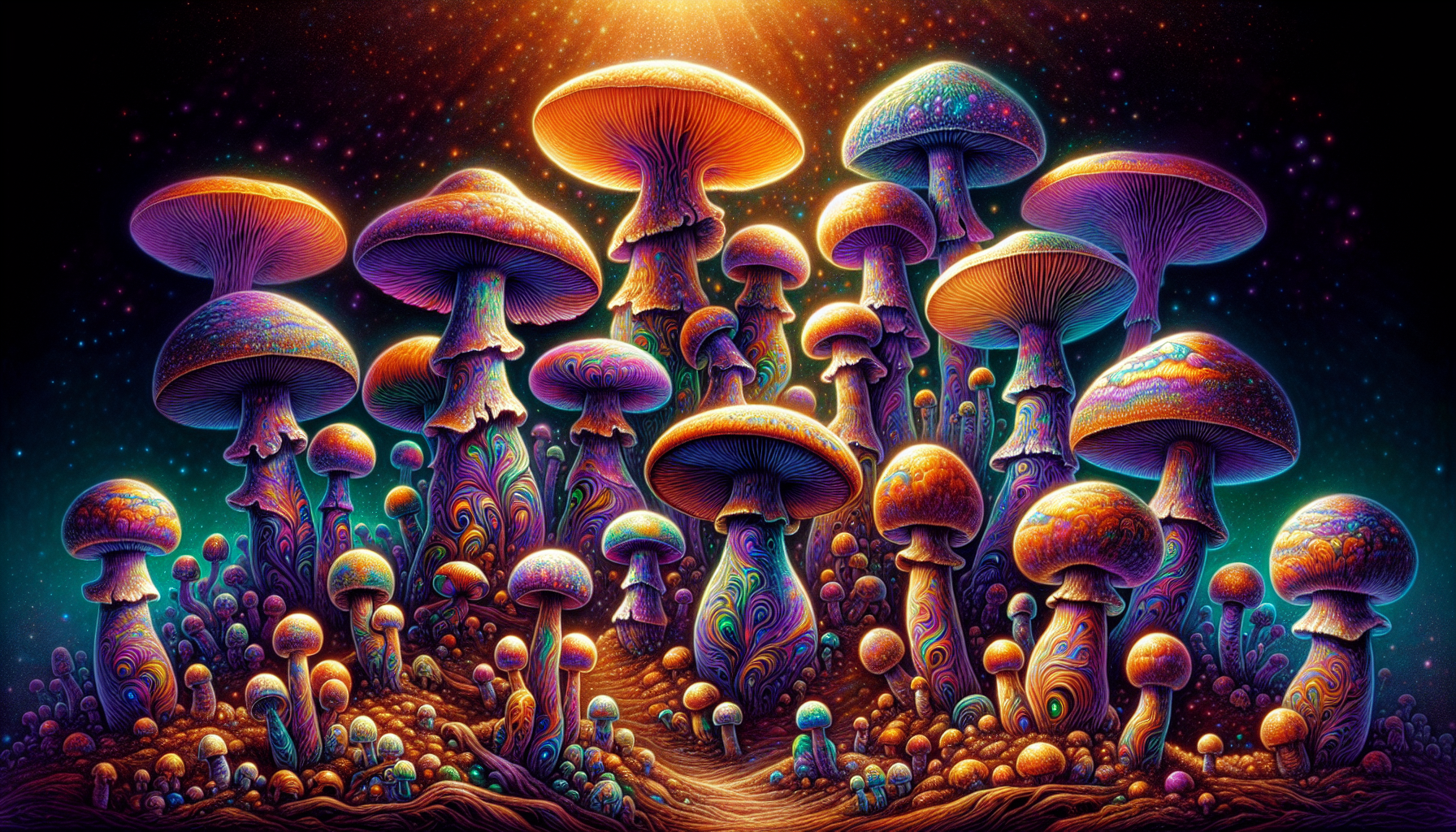
During the fruiting stage, mycelium initiates the production of mushrooms and develops fruiting bodies. To facilitate this phase, it’s essential to alter certain environmental factors such as temperature, humidity levels, and lighting.
Subsequent sections will offer detailed instructions on constructing a fruiting chamber tailored for mushroom cultivation while ensuring that conditions within remain ideal for their growth.
Setting Up the Fruiting Chamber
Establishing a controlled environment through a fruiting chamber is crucial for optimal mushroom growth conditions during the cultivation process. Whether opting for a shotgun fruiting chamber or employing a grow tent, these settings enable the maintenance of elevated humidity while ensuring adequate airflow. Monitoring with a hygrometer becomes particularly imperative in the initial phase of fruiting to ensure that moisture levels are within desired parameters.
For encouraging mushrooms to grow, incorporating an appropriate light source such as LED grow lights is essential. Exposure to indirect lighting over spans of several hours each day can effectively trigger the commencement of mushroom fruiting. Concurrently, maintaining proper ventilation is vital in sustaining fresh air exchange and controlling carbon dioxide concentrations within the chamber.
Maintaining Optimal Conditions
Ensuring the fruiting chamber maintains ideal conditions is crucial for fruitful magic mushroom cultivation. Temperature control should hover near 70°F while maintaining humidity within the range of 90-95% to foster optimal mushroom growth. Sufficient air exchange through proper ventilation promotes healthy development.
For mushrooms to thrive, they require a daily light exposure ranging from 8-14 hours under a light spectrum of approximately 5000-6000k. By establishing and regulating such an environment meticulously, cultivators are more likely to achieve consistent outcomes along with augmented yields in their magic mushroom production endeavors.
Harvesting Magic Mushrooms
To preserve both the potency and quality of magic mushrooms, it is essential to harvest them at an optimal time using correct methods. The upcoming subsections are dedicated to providing guidance on pinpointing the appropriate moment for harvesting these mushrooms as well as outlining superior techniques for their collection.
Identifying the Right Time to Harvest
Magic mushrooms reach their prime harvest time once the gills become visible and the edge of the cap starts to curl underneath. The optimal point for harvesting is right before the veil tears, signaling that they’re mature enough. This precise timing helps avoid spore dispersion which could potentially influence subsequent growth.
When you notice that the veil is turning darker and beginning to droop, it’s a definite indication that you should promptly commence with harvesting. Securing your magic mushrooms at just the right moment is essential in preserving both their quality and strength.
Proper Harvesting Techniques
During harvesting, it is advisable to use clean hands or sterile gloves, sterilized scissors, or a sharp knife to avoid contamination. Gently twist the mushrooms off at the base of the stem to minimize damage to the surrounding mycelium and substrate.
Harvest fresh mushrooms into a breathable container to preserve their quality and minimize handling. If preparing mushrooms for sale, harvest directly into final packaging to maintain their integrity.
Post-Harvest Processing and Storage
It is crucial to follow appropriate processing and storage procedures after harvesting to ensure that the potency and quality of your magic mushrooms are preserved.
Subsequent sections will discuss optimal techniques for dehydrating and preserving your mushroom crop.
Drying Methods
To initiate the drying process, adhere to these instructions.
-
Position the mushrooms on a surface that can absorb moisture well and is situated in an area with good airflow while avoiding exposure to direct sunlight.
-
Utilize a fan to enhance air movement around the mushrooms as it’s essential for decreasing their moisture content.
-
If employing a dehydrator, adjust its temperature settings between 95-105°F (35-40°C).
-
The duration of this dehydration process typically ranges from 6 to 12 hours.
Ensuring mushrooms are dried appropriately is key for preserving their psychoactive qualities and inhibiting any deterioration.
Place properly dried mushrooms—which should break or crack rather than bend—in containers that seal out air such as vacuum sealed plastic bags or glass jars for storage purposes. In instances where you don’t have access to a dehydrator, using an oven set at its lowest temperature with the door kept slightly open offers an alternative method for mushroom dehydration.
Long-Term Storage Solutions
Securing dried mushrooms in a vacuum sealed container and either refrigerating or freezing them can greatly prolong their shelf life. A storage temperature of 68°F (20°C) or below is optimal for preserving the quality of dried mushrooms. To safeguard them from light, which can degrade their potency, it’s advisable to store them in dark-colored containers. Incorporating desiccant packets within these storage units helps to capture any excess moisture.
Adhering to these preservation techniques guarantees that your magic mushrooms maintain their effectiveness over time, ensuring they are potent and available for use at your convenience.
Tips for Successful Mushroom Cultivation
To achieve success in cultivating magic mushrooms, one must exercise diligence, a meticulous nature, and the upkeep of an uncontaminated environment. Every phase within the mushroom cultivation journey is critical. It necessitates precision and cleanliness to fend off any impurities that could hinder their healthy development.
The choice of both appropriate mushroom species and substrate is pivotal in affecting your harvest outcomes. The correct selection can lead to a substantial increase in yields – with potential improvements up to threefold during favorable conditions. Consistent harvesting on a daily basis when temperatures are high aids in preserving the freshness of the mushrooms.
Maintaining quality after you have harvested your magic mushrooms is imperative for retaining their psychoactive compounds intact. By ensuring they undergo proper drying processes and storage methods, you can safeguard their efficacy and preserve their overall quality over extended periods.
Summary
Growing magic mushrooms is a fascinating and rewarding journey that combines science, art, and a bit of patience. By understanding the biology of psilocybin mushrooms, navigating legal considerations, and mastering the techniques of substrate preparation, inoculation, and fruiting, you can cultivate your own magic mushrooms successfully.
Remember, each step in the process is critical, from choosing the right method and maintaining optimal conditions to proper harvesting and storage. Whether you’re a novice or an experienced grower, following these guidelines will help you achieve bountiful harvests and enjoy the unique and profound benefits of magic mushrooms.
Frequently Asked Questions
What supplies are included in the Zombie Myco All In One Mushroom Grow Bag?
The Zombie Myco All In One Mushroom Grow Bag includes a sterile grow bag, alcohol wipe, and gloves. These supplies ensure a clean and safe environment for mushroom cultivation.
What is the first step in using the mushroom grow bag?
The first step in using the mushroom grow bag is to inoculate it by cleaning a surface, wearing gloves, sterilizing the needle, injecting spores, and then storing the bag in a cool, dark location.
How long should you wait after inoculating the grow bag?
You should wait approximately 3 weeks after inoculating the grow bag to allow sufficient time for mycelium development.
This timeframe ensures optimal growth conditions for your fungi.
What should you do in the "Mix" step?
In the “Mix” step, ensure the grain is 50-100% colonized, gently break up the mycelium growth, and thoroughly combine the grain and substrate layers before returning the bag to a cool, dark location for approximately three weeks.
What factors affect the possibility of getting a second flush of mushrooms?
The likelihood of achieving a second flush of mushrooms is heavily dependent on the success of the first harvest and efficient control over contamination.
By maintaining ideal conditions for growth, you can substantially increase your chances.

